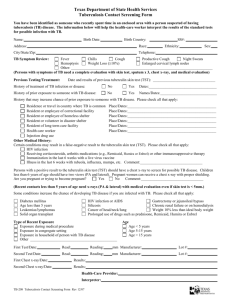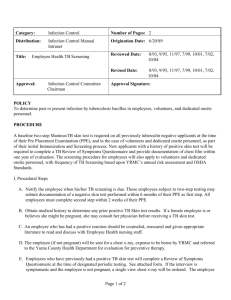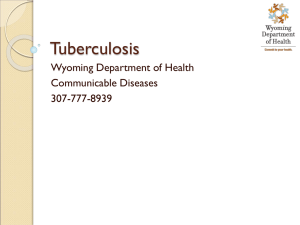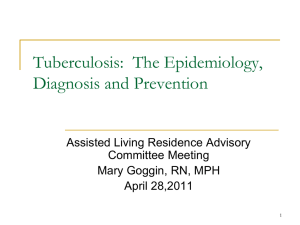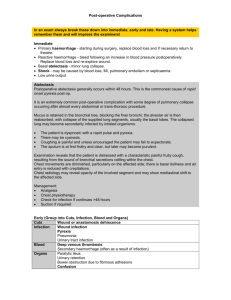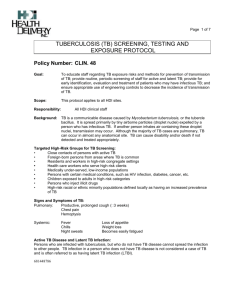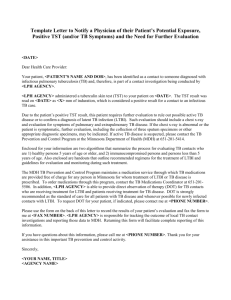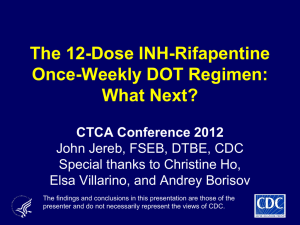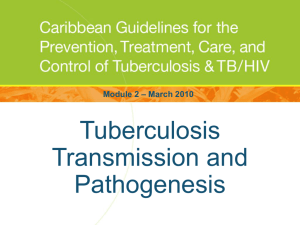Latent TB Infection - National Center for Health in Public Housing
advertisement
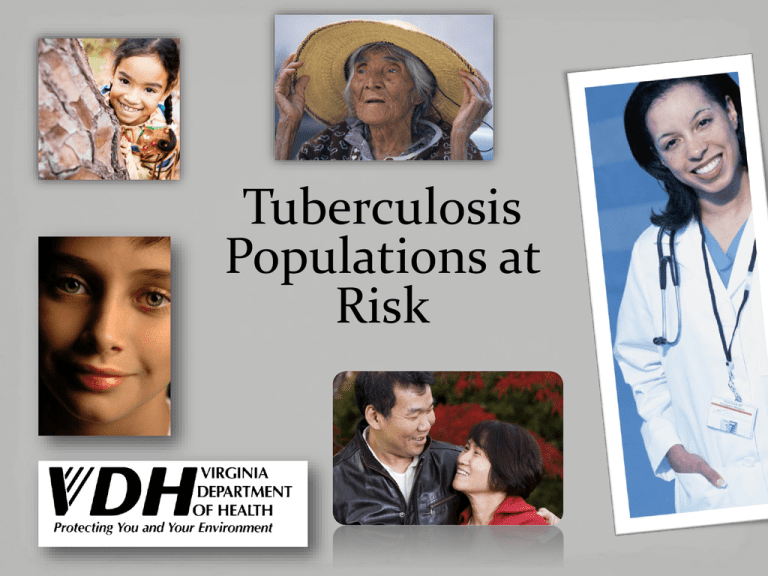
Tuberculosis Populations at Risk • One-third of the world is infected with TB, an average of one new infection per second • Two million people died from tuberculosis in 2010, 1 every 20 seconds • TB is the leading killer of those with HIV • TB is the 2nd leading killer from an infectious disease © WHO 2009 30,000 25,000 20,000 15,000 10,000 5,000 0 10,528 Percentage of TB Cases Among Foreign-born Persons, United States 2000 2011 DC DC >50% 25%–49% <25% Mexico (22%) Other Countries 39% Philippines (11%) Haiti (3%) Guatemala China (3%) (6%) Vietnam India (8%) (8%) U.S.-born Hispanic or Latino (19%) White (33%) American Indian or Alaska Native (3%) Asian (3%) Native Hawaiian or Other Pacific Islander (2%) Black or African American (39%) *All races are non-Hispanic. Persons reporting two or more races accounted for less than 1% of all cases. ** American Indian or Alaska Native and Native Hawaiian or Other Pacific Islander accounted for less than 1% of foreign-born cases and are not shown. TB An airborne bacterial disease caused by Mycobacterium tuberculosis Non Tuberculosis Mycobacterium (NTM) Slow growing Acid Fast: An organism that holds a red stain even in the presence of acid Appears “rough and buff” in standard culture 10 2 bronchiole blood vessel tubercle bacilli alveoli Multiplication begins Spread throughout the body 11 In 2 – 8 weeks a special 4 type of white blood cell surrounds the TB bacteria This ‘barrier shell’ keeps the TB contained and under control This condition is called LTBI In 8 – 10 weeks infection is detected by the tuberculin skin test or TST Group Risk Close contacts Pathogenesis - Two years Immigrants Country of Origin Travel to foreign country Environmental Congregate setting employees Environmental Congregate setting residents Environmental Children exposed to high risk adults Environmental Medically underserved, homeless Environmental Substance abuser Environmental HIV positive or at risk for HIV infection Children ≤ 4 yrs old and adolescents Certain medical conditions Injection drug users Prior untreated TB or fibrotic lesions on chest radiograph suggestive of past TB Underweight or malnourished Receiving TNF-α antagonists for treatment of rheumatoid arthritis or Crohn’s disease *Probability of developing TB if exposed, compared to those who are not exposed 10% life time chance that TB disease will develop 5% within the first 2 years after infection 5% remaining of their lifetime Infection Disease General Fatigue/Malaise Poor Appetite Weight loss Elevated temperature Night Sweats Pulmonary Cough Shortness of Breath Chest Pain Hemoptysis 80-85% Laryngeal TB is VERY contagious Symptoms will vary dependent on site History Exposure Vulnerability Bacteriology AFB smear and culture X 3 Symptoms Chest X-ray Upper lobes Cavitary History Bacteriology Symptoms Chest x-ray Latent TB Infection (LTBI) Active TB Disease Tubercle bacilli in the body Tuberculin skin test reaction or IGRA usually positive No symptoms Symptoms Chest x-ray normal or not consistent with TB Chest x-ray usually abnormal Not infectious Often infectious (sputum) Not a Case of TB Case of TB Strongest risk factor for progression from LTBI to active TB disease Estimated risk is 20 to 37 times greater CD4 count + viral load Difficult to diagnose and treat CXR Sputum Testing for infection Drug/drug interactions All HIV patients should be screened for TB annually All TB patients should be tested for HIV Globally: found in ALL regions of the world 50%: China, India and Russia United States: all states have been impacted 80% are foreign born Mexico, Philippines, Vietnam, India, China, Haiti, Korea, Peru, Ecuador, Guatemala, Ethiopia, Honduras Primary Cause Inadequate treatment Non-adherence Incorrect regimen Gold Standard: method using 0.1 ml of Purified Protein Derivative for identifying persons with Latent TB Infection Accurate results are dependent upon: Correct Handling Correct History Correct Technique TB Screening a thorough patient history is taken by asking questions relevant to potential TB exposure Baye’s theorum: Inverse probability principle - The accuracy of your test is dependent upon the prevalence of the disease in the population The lower the risk in a population the lower the accuracy of a test TST Testing Specificity and Sensitivity is 20% - 40% > 5 mm close contacts and HIV- infected individuals > 10 mm other persons at risk > 15 mm all others not in the above categories Given to prevent serious forms of TB disease in very young children Used in countries where TB is endemic BCG does not preclude skin testing for TB infection Beneficial for groups who will have serial TST’s A person’s immune system tends to stop reacting strongly to the TB bacteria over time Do two step testing to avoid misinterpreting the results of the second TST as a new infection Blood Test – diagnose LTBI T-spot QuantiFERON Advantages Disadvantages Single patient visit Local availability Results available in 24 hours Stringent processing No boosting effect More expensive than the TST Less subject to reader bias Limited data on it’s use Does not cross react with BCG Not for use in children > 5 Positive TST or IGRA Asymptomatic Negative Chest x-ray Drug Dosage Length of treatment # of Doses Isoniazid 300mgs/daily 9 months (6 mths) 270 (180) Rifampin 600 mgs/daily 4 months (6 mths) 120 (180) Rifapentine/ Isoniazid 600 mgs 300 mgs Once weekly 3 months by DOT 12 Short Course Treatment Rifapentine (Priftin)/Isoniazid 3HP Pros Shorter duration of treatment 3 months Individuals more likely to complete therapy (82% vs 69%) Similar amount of adverse drug events in each group Expense Cons Availability Must be by DOT - directly observed therapy Pill burden Not recommended for: HIV positive patients Children under 2 Pregnant women Contacts to MDR index case http://www.cdc.gov/tb Links to major guidelines Treatment of TB TB Testing and Treatment for Latent Infection Infection Control in Facilities Others The “Standards For Care” Http://Www.Cdc.Gov/Tb/Publications/Guidelines/Default.Htm State TB Control Offices Key contacts for information on epi and TB services in your state and locality http://www.cdc.gov/tb/links/tboffices.htm http://www.tbcontrollers.org/community/statecityterritory/ Regional Training and Medical Consultation Centers Phone consultation for difficult to manage patients http://www.cdc.gov/tb/education/rtmc/default.htm Online Continuing Education Opportunities http://www.cdc.gov/tb/education/CE/default.htm Fact Sheets http://www.cdc.gov/tb/publications/factsheets/default.htm Educational Materials for Providers http://www.cdc.gov/tb/education/provider_edmaterials.htm CDC Patient and Public Educational Materials http://www.cdc.gov/tb/education/patient_edmaterials. htm Materials for non-readers and non-English speakers Audio, multimedia, mobile apps http://www.healthyroadsmedia.org/ Denise Dodge, RN TB Nurse Consultant Virginia Department of Health Denise.Dodge@vdh.virginia.gov Jane Moore, RN, MHSA Director, Tuberculosis Control and Newcomer Health Programs Virginia Department of Health Jane.Moore@vdh.virginia.gov
